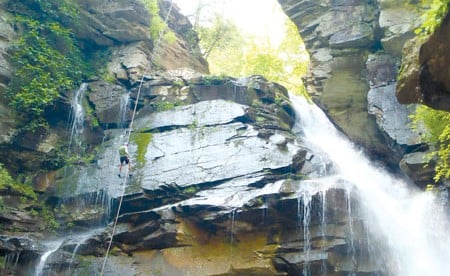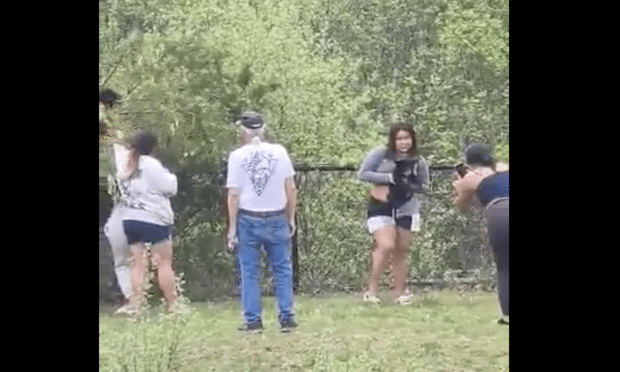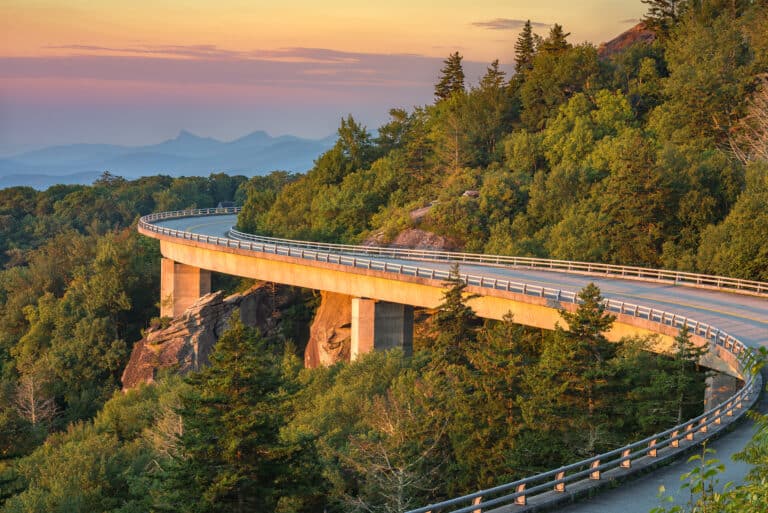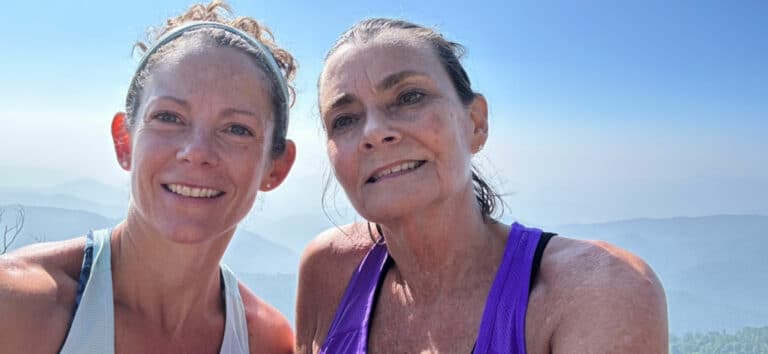The sound of falling water is like a siren’s song, relentlessly luring me to get in on the action. There’s just something about the power of unconstrained water that excites me. So I decided to get as close as possible to one of the region’s most rugged and remote waterfalls.
A guide from Green River Adventures was leading me on my first rappel of Bradley Falls. Though I love water, I don’t love willingly walking over the edge and trusting a rope for my survival. Overcoming my anxiety meant being able to experience Bradley Falls up close and personal, an experience nothing short of an encounter with the divine.
Getting Started
I arrive at Green River Adventure’s outpost on Main Street, an all wood exterior building where I meet guide Jim Wall. He greets me with a broad-dimpled smile that extends to his eyes. He exudes the laid-back confidence of someone at ease in nature. After earning a degree in outdoor education from Brevard College, he’s put it to good use by leading kayaking, hiking, and rappelling trips.
With an ever-so-slight Alabama twang, he provides an overview of the day: drive to the trailhead; hike about a mile to our rappel site; set up to rappel about 30 feet down to the first ledge. “At that point, you’ll be standing in a waist-deep pool of water about 10 feet wide,” he said. “From there, you’ll rappel down the second stretch to the bottom of the falls. Sound good?”
Hiking Along Cove Creek
At the trailhead, the evergreens and hemlocks create a dense canopy overhead. Jim loads two waterproof 70-meter ropes into a huge backpack.
I offer to carry one of the ropes, but he waves me off with a flick of his wrist, hoisting the heavy pack.
We begin our hike into the serene and curvaceous Green River Game Lands, the trail following the exquisite Cove Creek, a clear deep blue-green ribbon of water, which gently meanders some forty feet below our path. My stomach churns at the prospect of the rappel ahead, so I concentrate on taking a few deep inhales. The clean smell of spring greets my nose – an energizing blend of unfurling leaves and a recent rain.
Jim asks, “Have you ever seen a Hellbender?”
I ponder whether this is another Southern term I’ve yet to encounter, envisioning a motorcycle rider who’s missing at least one front tooth, raising a ruckus at his neighborhood bar after being told they ran out of his favorite beer.
Jim explains that a Hellbender is salamander—the largest one in North America. “They look as if they’ve been stepped on, they’re so flat. And they can grow to be over two feet long. They look scary at first, but they’re harmless.”
I almost forget about the rappel altogether until we reach a very distinct horizon line. The once meandering water now violently plunges downward off the steep drop.
At the Ledge
Jim sets up the anchor station for our rappel. I peer over the edge, where Cove Creek continues downstream. After the falls, the creek itself becomes steeper and more dramatic, studded with boulders and smaller drops. Steep, rugged rocky faces on the other side of the gorge offer a stark contrast to the otherwise lush, green environment. I had heard rumors of hikers plunging to their death at this spot, and it isn’t hard to imagine a deadly fall where the terrain is so steep and nothing at all protects an unwary hiker from the edge.
I ask, “How secure is the anchor?”
He reassures me that the anchors were set by the best in the business. Indulging in fears happens quickly at the edge. As much as I can’t wait to get a glimpse of the falls, I feel quite pleasant standing with both feet on the ground. I worry about letting go with my brake hand. And faced with the prospect of cold water splashing me, I relish feeling nice and snug in my dry clothes. But staying comfortable means going only where I have already gone and knowing what I already know. The cost of staying secure and dry might just be settling for existing in the mundane grind of to-do lists instead of living the adventurous life I crave.
Jim brings me back from my reverie. “Good job tying your hair back. My biggest fear is someone getting her hair getting caught up in the belay line.” I glance up and he gives me a quick wink. That’s all the encouragement I need to put my nagging doubts to rest.
I tie into the belay line and inch my way toward the anchor where the second rope hangs, the rope from which I will rappel. I feed the belay rope through my belay device and position my break hand.
Going Over the Edge
I sit back into my harness, sinking all my weight into my butt, and leaning back so that my feet jut out at a ninety degree angle. Jim’s instructions become my mantra: wide and steady. With my feet far apart, I walk myself down by taking small steps, feeling completely stable and comfortable.
There is a lot going on all at once – the roar of the water, the sensation of dangling from a rope, and the feeling of icy water splash me. I literally just hang for a few minutes. Below me is a pool of water, which cascades over another ledge all the way down to where Cove Creek resumes its journey to eventually meet the Green River. The undeniable power of the falls is mesmerizing. The beauty of the falls is so raw, the vibrant green of the moss juxtaposed against the shiny, wet brown rock. It seems impossible that I am only a few miles as the crow flies from the interstate. I close my eyes for a minute, etching every detail in my mind so that I can return to this moment, even if only as a memory.
The Pool and Second Ledge
I complete my descent down the first section and reach the pool below. True to Jim’s description, I’m standing in waist-deep water, grunting with effort as I pull the heavy rope to create enough slack to walk through the pool. I climb onto the second ledge.
Jim had warned me that the rocks here would be slippery, and he wasn’t kidding. Even with river shoes secure on the smoothest of granite, I find little purchase. But with care, I manage to negotiate the slippery rocks.
Confidence exists where there once was hesitation. My body quickly finds a rhythm, slowly releasing rope with my brake hand to lower myself down the rock face. I am beaming now at the waterfall and the rock, a smile so ridiculously big and happy. Purposefully moving my body in the path of a jet of water, I duck my head under for a refreshing rinse. I belay slowly the rest of the way down, so reluctant am I to leave my waterfall wonderland.
Back on Solid Ground
When my feet reach the bottom, I find myself standing in Cove Creek. I scramble to find a non-slippery spot where I can safely undo the ropes without falling. I give the rope three big tugs, and moments later, Jim begins his own rappel.
Waterfalls are nature’s very own feel good machines. Negative ions, the so-called “vitamins of the air,” are molecules with an extra electron attached. The effect of this extra electron is to boost the serotonin levels in our brains. According to the Center for Applied Sciences, “Negative ions increase the flow of oxygen to the brain, resulting in higher alertness, decreased drowsiness, and more mental energy.”
After the day’s rappel, I’m a believer in negative ions. I feel expanded and stretched. My thoughts are all adrenaline-induced exuberance and giddiness. My body tingles with the sense of awe that has completely replaced my fear.
Saluda, N.C. Makes the Grade
Best known as the town at the top of the steepest mainland railroad line east of the Rockies, Saluda, N.C. is also making the grade as an outdoor destination. Before the railroad, Saluda was just a crossroad for traders and herders. Built in 1878 to connect the Asheville and Spartanburg railroads, hotels and boarding houses soon started popping up to house railroad employees. Tourists started taking the train, ascending 600 feet per mile, to visit the mountain town. Artists and writers such as F. Scott Fitzgerald and Dorothy Dix stayed in Saluda in those days.
Today Saluda’s steep grade draws another type of visitor—outdoor enthusiasts. The steep grade translates into winding roads for road cyclists, challenging paddling for whitewater kayakers, and technical pedaling for mountain bikers. Eco-tourists visit the area to paddle an inflatable kayak down the Upper Green, fly fish, or stand- up-paddle on the Lower Green. Downtown Saluda offers a host of good choices for refueling after a day of outdoor play.








